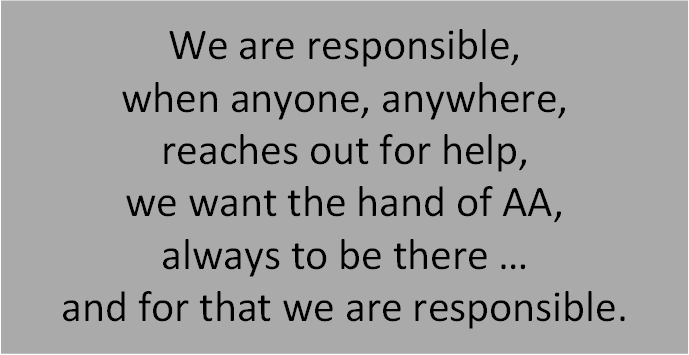Serenely remarking to his attendant, “I think this is it,” Dr. Bob passed out of our sight and hearing November 16, 1950 at noonday. So ended the consuming malady wherein he had so well shown us how high faith can rise over grievous distress. As he had lived, so he had died, supremely aware that in his Father’s house are many mansions.
In all those he memory was at flood-tide. But who could really say what was thought and felt by the 5,000 sick ones to whom he personally ministered and freely gave a physician’s care; who could possibly record the reflections of his townsmen who had seen him sink almost within the grasp of oblivion, then rise to anonymous world renown; who could express the gratitude of those tens of thousands of AA families who had so well heard of him but had never seen him face to face? What, too, were the emotions of those nearest him as they thankfully pondered the mystery of his regeneration fifteen years ago and all its vast consequences since? Not the smallest fraction of this great benefaction could be comprehended. He could only declare, “What indeed hath God wrought?”
Never would Dr. Bob have us think him saint or superman. Nor would he have us praise him or grieve his passing. He can almost be heard, saying, “Seems to me you folks are making heavy going. I’m not to be taken so seriously as all that. I was only a first link in that chain of providential circumstances which is call AA. By grace and great fortune my link did not break; though my faults and failures might often have brought on that unhappy result. I was just another alcoholic trying to get along — under the grace of God. Forget me, but go you and do likewise. Securely add your own link to our chain. With God’s help, forge that chain well and truly.” In this manner would Dr. Bob estimate himself and counsel us.
It was a Saturday in May 1935. An ill-starred business venture had brought me to Akron where it immediately collapsed, leaving me in a precarious state of sobriety. That afternoon I paced the lobby of Akron’s Mayflower Hotel. As I peered at the gathering crowd in the bar, I became desperately frightened of a slip. It was the first severe temptation since my New York friend had laid before me what were to become the basic principles of AA, in November 1934. For the next six months I had felt utterly secure in my sobriety. But now there was not security; I felt alone, helpless. In the months before I had worked hard with other alcoholics. Or, rather, I had preached at them in a somewhat cocksure fashion. In my false assurance I felt I couldn’t fall. But this time it was different. Something had to be done at once.
Glancing at a church directory at the far end of the lobby, I selected the name of a clergyman at random. Over the phone I told him of my need to work with another alcoholic. Though I’d had no previous success with any of them I suddenly realized how such work had kept me free from desire. The clergyman gave me a list of ten names. Some of these people, he was sure, would refer me a came in need of help. Almost running to my room, I seized the phone. But my enthusiasm soon ebbed. Not a person in the first nine called could, or would, suggest anything to meet my urgency.
One uncalled name still stood at the end of my list — Henrietta Seiberling. Somehow I couldn’t muster courage to lift the phone. But after one more look into the bar downstairs something said to me, “You’d better.” To my astonishment a warm Southern voice floated in over the wire. Declaring herself no alcoholic, Henrietta nonetheless insisted that she understood. Would I come to her home at once?
Because she had been enabled to face and transcend over calamities, she certainly did understand mine. She was to become a vital link to those fantastic events which were presently to gather around the birth and development of our AA Society. Of all names the obliging rector had given me, she was the only one who cared enough. I would here like to record our timeless gratitude.
Straightaway, she pictured the plight of Dr. Bob and Anne. Suiting action to her word, she called their house. As Anne answered, Henrietta described me as a sobered alcoholic from New York who, she felt sure, could help Bob. The good doctor had seemingly exhausted all medical and spiritual remedies for his condition. Then Anne replied, “What your say, Henrietta, is terribly interesting. But I am afraid we can’t do anything now. Being Mother’s Day, my dear boy has just brought in a fine potted plant. The pot is on the table but, alas, Bob is on the floor. Could we try to make it tomorrow?” Henrietta instantly issued a dinner invitation for the following day.
At five o’clock next afternoon, Anne and Dr. Bob stood at Henrietta’s door. She discreetly whisked Bob and me off to the library. His words were, “Mighty glad to meet you, Bill. But it happens I can’t stay long; five or ten minutes at the outside.” I laughed and observed “Guess you’re pretty thirsty aren’t you?” His rejoinder was, “Well, maybe you do understand this drinking business after all.” So began a talk which lasted hours.
How different my attitude was this time. My fright of getting drunk had evoked a much more becoming humility. After telling Dr. Bob my story, I explained how truly I needed him. Would he allow me to help him, I might remain sober myself. The seed that was to flower as AA began to grow toward the light. But as dear Anne well guessed, that first tendril was a fragile thing. Practical steps had better be taken. She bade me come and live at their menage for a while. There I might keep an eye on Dr. Bob. And he might on me. This was the very thing. Perhaps we could do together what we couldn’t do separately. Besides I might revive my sagging business venture.
For the next three months I lived with these tow wonderful people. I shall always believe they gave me more than I ever brought them. Each morning there was devotion. After the long silence Anne would read out of the good book. James was our favorite. Reading him from her chair in the corner, she would softly conclude “Faith without works is dead.”
But Bob’s travail with alcohol was not quite over. That Atlantic City Medical Convention had to be attended. He hadn’t missed one in twenty years. Anxiously waiting, Anne and I heard nothing for five days. Finally his office nurse and her husband found him early one morning at the Akron railroad station in some confusion and disarray — which puts it mildly. A horrible dilemma developed. Dr. Bob had to perform a critical surgical operation just three days hence. Nor could an associate substitute for him. He simply had to do it. But how? Could we ever get him ready in time?
He and i were placed in twin beds. A typical tapering down process was inaugurated. No much sleep for anybody, but he cooperated. At four o’clock on the morning of the operation he turned, looked at me, and said, “I am going through with this.” I inquired, “You mean you are going through with the operation?” He replied, “I have placed both the operation and myself in God’s hands. I’m going to do what it takes to get sober and stay that way.” Not another word did he say. At nine o’clock he shook miserably as we helped him into his clothes. We were panic stricken. Could he ever do it? Were he too tight or too shaky, it would make little difference, his misguided scalpel might take the life of his patient. We gambled. I game him one bottle of beer. That was the last drink he ever took. It was June 10, 1935. The patient lived.
Our first prospect appeared; a neighbouring person sent him over. Because the newcomer faced eviction, Anne took in his whole family, wife and two children. The new one was a puzzler. When drinking, he’d go clean out of his mind. One afternoon Anne sat at her kitchen table, calmly regarding him as he fingered a carving knife. Under her steady gaze, his hand dropped. But he did not get sober then. His wife despairingly betook herself to her own parents and he disappeared. But he did reappear fifteen years later for Dr. Bob’s last rites. There we saw him, soundly and happily sober in AA. Back in 1935 we weren’t so accustomed to miracles as we are today; we had given him up.
Then came a lull on the Twelfth Step front. In this time Anne and Henrietta infused much needed spirituality into Bob and me. Lois came to Akron on vacation from her grind at a New York department store, so raised our morale immensely. We began to attend Oxford Group meetings at the Akron home of T. Henry Williams. The devotion of this good man and his wife is a bright page in memory. Their names will be inscribed on page one of AA’s book of first and best friends.
One day Dr. Bob said to me, “Don’t you think we’d better scare up some drunks to work on?” He phoned the nurse in charge of admissions at Akron City Hospital and told her how he and another drunk from New York had a cure for alcoholism. I saw the old boy blush and look disconcerted. The nurse and commented, “Well, Doctor, you’d better give that cure a good workout on yourself.”
Nevertheless the admitting nurse produced a customer. A dandy, she said he was. A prominent Akron lawyer, he had lost about everything. He’d been in City Hospital six times in four months. He’d arrived at that very moment; had just knocked down a nurse he’d thought was a pink elephant. “Will that one do you?” she inquired. Said Dr. Bob, “Put him in a private room. We’ll be down when he’s better.”
Soon Dr. Bob and I saw a sight which tens of thousands of us have since beheld, the sight of the man on the bed who does not yet know he can get well. We explained to the man on the bed the nature of his malady and told him our own stories of drinking and recovery. But the sick one shook his head, “Guess you’ve been through the mill boys, but you never were half as bad off as I am. For me it’s too late. I don’t dare go out of here. I’m a man of faith, too; used to be deacon in my church. I’ve still faith in God but I guess he hasn’t got any in me. Alcohol has me, it’s no use. Come and see me again, though. I’d like to talk with you more.”
As we entered his room for our second visit a woman sitting at the foot of his bed was saying, “What has happened to you, husband? You seem so different. I feel relieved.”
The man turned to us. “Here they are,” he cried. “They understand. After they left yesterday I couldn’t get what they told me out of my mind, I lay awake all night. Then hope came. If they could find release, so might I. I became willing to get honest with myself, to square my wrongdoing, to help other alcoholics. The minute I did this I began to feel different. I knew I was going to be well.” Continued the man on the bed, “Now, good wife, please fetch my clothes. We are going to get up and out of here.” Whereupon AA number three arose from his bed, never to drink again. The seed of AA had pushed another tendril up through the new soil. Though we knew it not, it had already flowered. Three of us were gathered together. Akron’s Group One was a reality.
We three worked with scores of others. Many were called but mighty few chosen; failure was our daily companion. But when I left Akron in September 1935, two or three more sufferers had apparently linked themselves to us for good.
The next two years marked the “flying blind” period of our pioneering time. With the fine instinct of that good physician he was, Dr. Bob continued to medically treat and indoctrinate every new case, first at Akron City Hospital, then for the dozen years since at famed St. Thomas where thousands passed under his watchful eye and sure AA touch. Tough not of his faith, the staff and sisters there did prodigies. Theirs is one of the most compelling examples of love and devotion we AAs have ever witnessed. Ask the thousands of AA visitors and patients who really know. Ask them what they think of sister Ignatia, of St. Thomas. Of of Dr. Bob. But I’m getting ahead of my story.
Meanwhile a small group had taken shape in New York. The Akron meeting at T. Henry’s home began to have a few Cleveland visitors. At this juncture I spent a week visiting Dr. Bob. We commenced to count noses. Out of hundreds of alcoholics, how many had stuck? How many were sober? And for how long? In that fall of 1937 Bob and I counted forty cases who had significant dry time — maybe sixty years for the whole lot of them! Our eyes glistened. Enough time had elapsed on enough cases to spell out something quite new, perhaps something great indeed. Suddenly the ceiling went up. We no longer flew blind. A beacon had been lighted. God had shown alcoholics how it might be passed from hand to hand. Never shall I forget that great and humbling hour of realization, shared with Dr. Bob.
But the new realization faced us with a great problem, a momentous decision. It had taken nearly three years to effect forty recoveries. The United States alone probably had a million alcoholics. How were we to get the story to them? Wouldn’t we need paid workers, hospitals or our own, lots of money? Surely we must have some sort of a textbook. Dare we crawl at a snail’s pace whilst our story got garbled and mayhap thousands would die? What a poser that was!
How we were spared from professionalism, wealth, and extensive property management; how we finally came up with the book Alcoholics Anonymous is a story by itself. But in this critical period it was Dr. Bob’s prudent counsel which so often restrained us from rash ventures that might have retarded us for years, perhaps ruined us for good. Nor can we ever forget the devotion of Dr. Bob and Jim S. (who passed away last summer) as they gathered stories for the AA Book, three-fifths of them coming from Akron alone. Dr. Bob’s special fortitude and wisdom were prime factors in that time so much characterized by doubts, and finally by grave decision.
How much we may rejoice that Anne and Dr. Bob both lived to see the lamp lit at Akron carried into every corner of the earth; that they doubtless realized millions might someday pass under the ever widening arch whose keystone they so gallantly helped carve. Yet, being so humble as they were, I’m sure they never quite guessed what a heritage they left us, nor how beautifully their appointed task had been completed. All they needed to do was finished. It was ever reserved for Dr. Bob to see AA come of age as, for the last time, he spoke to 7,000 of us at Cleveland, July 1950.
I saw Dr. Bob the Sunday before he died. A bare month previous he had aided me in framing a proposal for the General Service Conference of Alcoholics Anonymous, AA’s Third Legacy. This bequest, in pamphlet form, was actually at the printers when he took his final departure the following Thursday. As his last act and desire respecting AA, this document will be sure to carry a great and special meaning for us all.
With no other person have I ever experienced quite the same relation: The finest thing I know how to say is that in all the strenuous time of our association, he and I never had an uncomfortable difference of opinion. His capacity for brotherhood and love was often beyond my ken.
For a last word, may I leave with you a moving example of his simplicity and humility. Curiously enough, the story is about a monument — a monument proposed for him. A year ago, when Anne passed away, the thought of an imposing shaft came uppermost in the minds of many. People were insistent that something be done. Hearing rumors of this, Dr. Bob promptly declared against AA’s erecting for Anne and himself any tangible memorial or monument. These usual symbols of personal distinction he brushed aside in a single devastating sentence. Said he, “Annie and I plan to be buried just like other folks.”
At the alcoholic ward in St. Thomas his friends did, however, erect this simple plaque. It reads: “In Gratitude: The friends of Dr. Bob and Anne Smith affectionately dedicate this memorial to the sisters and staff of St. Thomas Hospital. At Akron, birthplace of Alcoholics Anonymous, St. Thomas Hospital became the first religious institution ever to open its door to our Society. May the loving devotion of those who labored here in our pioneering time be a bright and wondrous example of God’s grace everlastingly set before us all.”
Copyright © AA Grapevine, Inc January 1951 Reprinted with permission




